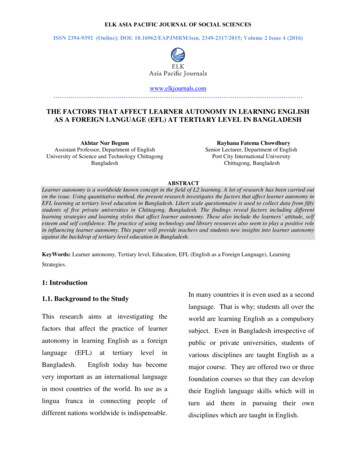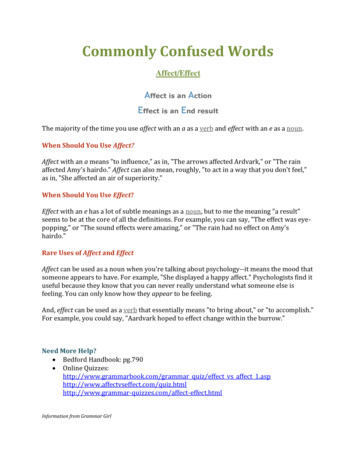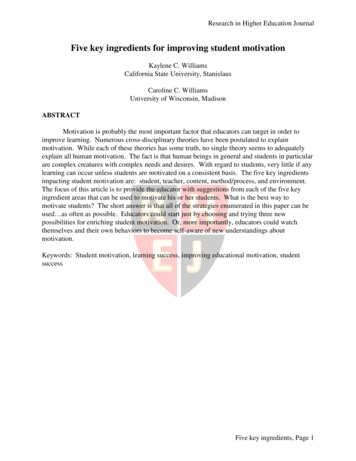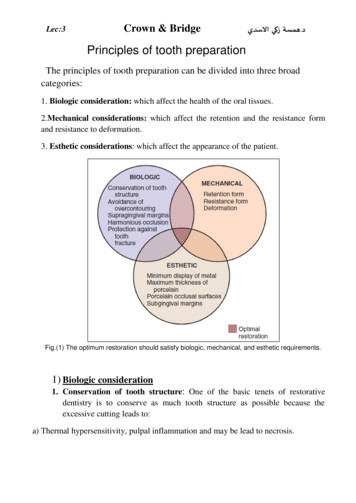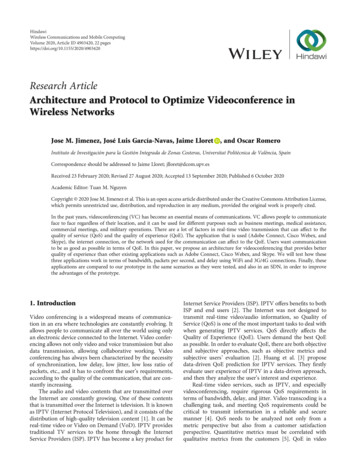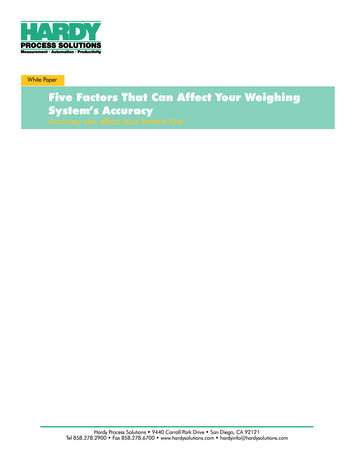
Transcription
White PaperFive Factors That Can Affect Your WeighingSystem’s AccuracyAccuracy can affect your bottom lineHardy Process Solutions 9440 Carroll Park Drive San Diego, CA 92121Tel 858.278.2900 Fax 858.278.6700 www.hardysolutions.com hardyinfo@hardysolutions.com
INTRODUCTIONYou can ensure that your weighing system performs accurately by choosing components suited to yourapplication and taking steps to control environmental and other forces acting on the system. This articlediscusses five factors that can affect the weighing system’s accuracy and provides advice on selecting,installing, and operating the system to handle these factors.Weighing to measure dry bulk material quantities and flowrates has several benefits: Unlike volumetricmeasurement, weighing can measure a material quantity without correction factors for the material’sbulk density. Weighing doesn’t require contact with the material, making it suitable for measuring corrosive materials and operating in corrosive environments. It’s also a widely accepted means of quantifyingpackaged products for sale.A weighing system can take any of several forms but typically includes one or more load cells that support (or suspend) a weigh vessel or platform, a junction box, and a weight controller. When a load isapplied to the weigh vessel or platform, a portion of the load is transmitted to each load cell. Each cellsends an electrical signal proportional to the load it senses via a cable to the junction box. The loadcell signals are summed in the junction box and sent via one larger cable to a weight controller, whichconverts the summed signal to a weight reading. This weight reading’s accuracy can be affected by thesystem components’ quality and the system’s installation and operation in your environment.To help you choose high-quality weighing system components, take advantage of the expertise ofweighing equipment suppliers. An important part of this selection process is determining how the systemwill be installed and what factors can affect its operation once it’s up and running in your process line.Consider how these five factors can affect your system’s weighing accuracy:1.2.3.4.5.2Load cell accuracyLoad factorsEnvironmental forcesInterference with signal transmissionInstrumentation and controlWhite Paper Five Factors that Can Affect Your Weighing Systems Accuracy
1Load cell accuracySelecting a top-quality load cell for your weighing system is the first step in obtaining weighingaccuracy. The load cell (also called a load sensor or transducer) is a piece of machined metal thatbends with the load’s mechanical force and converts the mechanical force into an electrical signal.The bend doesn’t exceed the metal’s elasticity and is measured by strain gauges bonded at points onthe cell. As long as the load is applied to the proper spot on the load cell, the strain gauges provide aproportional electrical signal. The key specifications for a load cell that will provide accurate weight information are: Nonlinearity: 0.018 percent of the load cell’s rated output. Hysteresis: 0.025 percent of the load cell’s rated output. Non-repeatability: 0.01 percent of the load cell’s rated output. Creep: 0.01 percent of the load cell’s rated output in 5 minutes. Temperature effect on output: 0.0008 percent of the load per degree Fahrenheit. Temperature effect on zero: 0.001 percent of the load cell’s rated output per degree Fahrenheit.Understanding the specifications.Although every specification won’t necessarily apply to your weighing system installation, it’s importantto understand each specification to determine the load cell’s combined accuracy.Non-linearity is the load cell calibration curve’s maximum deviation from a straight line, starting atzero load and ending at the cell’s maximum rated capacity. Non-linearity measures the cell’s weighingerror over its entire operating range. The worst-case non-linearity specification of 0.018 percent isseen over the load cell’s full range. The smaller the change in weight on your load cell, the smaller theerror resulting from non-linearity.3White Paper Five Factors that Can Affect Your Weighing Systems Accuracy
Hysteresis is the difference between two load cell output readings for the same applied load -- onereading obtained by increasing the load from zero, the other by decreasing the load from the load cell’smaximum rated capacity. As with nonlinearity, the worst-case 0.025 percent hysteresis specificationis seen over the load cell’s full range, and the error caused by hysteresis diminishes with small weightchanges. In an application such as batching, where you typically need accurate weight measurementsonly during filling, you can ignore the error caused by hysteresis. Hysteresis error normally falls into adifferent region on a load cell’s calibration curve than non-linearity error, as shown in Figure 1. As aresult, the specifications for these two errors are combined on some load cells into an algebraic sum,called a combined error specification, of 0.03 percent.Non-repeatability is the maximum difference between load cell output readings for repeatedloadings under identical loading conditions (that is, either increasing the load from zero or decreasingthe load from the load cell’s maximum rated capacity) and environmental conditions. The nonrepeatability specification is 0.01 percent over the load cell’s full range. Non-repeatability canaffect the weight measurement in any weighing application. You can determine the worst-case nonrepeatability specification by adding the non-repeatability error to the load cell’s combined error.Creep is the change in load cell output over time when a load remains on the cell for a long time.In a 2- to 3-minute batch or filling cycle, creep isn’t a significant problem. But if you use load cells tomonitor inventory in a storage silo, you need to consider creep effects.Temperature changes can cause weighing errors. Most load cells are temperature-compensatedto reduce these errors. But if your weighing system is subject to large temperature changes during theweighing cycle -- for example, if an outdoor weigh vessel is exposed to low overnight temperatures butheats up quickly in the daytime sun -- consider how temperature can affect the load cell output. If theonly significant change affecting your weighing system is between summer and winter temperatures,you can recalibrate the load cells once when the season changes to correct for any temperature-causederrors.Temperature changes affect load cell output by changing the load cell’s sensitivity, and you mustconsider this effect unless you perform a new calibration for each large temperature change. Thetemperature effect on the load cell at zero load causes the cell’s entire output range to shift. But if theload cell re-zeroes (that is, tares in the net-weight mode) before it starts the weighing cycle -- such as ina batching application -- you don’t need to be concerned about this temperature effect on zero load.Considering your load cell’s response timeThe load cell’s response time is another factor to consider for some applications. The typical loadcell behaves like a stiff spring that oscillates, so to achieve an accurate weight reading, the load cellmust settle -- that is, stop oscillating -- in less time than the required weighing period. While load cellresponse time is typically not important for a batching application, a high-speed checkweighing orrotary filling machine requires fast-responding load cells. Such load cells dampen their own naturaloscillating frequency when a load is applied to them. However, the load cells don’t reject vibrationsapplied to them from outside sources, such as nearby equipment, so you still need to isolate the loadcells from brate the load cells once when the season changes to correct for any temperature-causedsuch vibration sources (covered in more detail in the later section “Environmental Forces”).4White Paper Five Factors that Can Affect Your Weighing Systems Accuracy
2Load factorsEnsure that the load is applied to each load cell in your weighing system as specified by themanufacturer. An improperly applied load, such as a twisting load, causes the strain gauges in the cellto experience strain and send a signal change proportional to the twisting rather than the load’s weight.For accurate weighing, the load cells alone must support all the weight to be measured. For example,rigid conduit connections and rigidly mounted piping on a weigh vessel will support some of the loadand prevent the total load from being transmitted to the load cells. To avoid this problem, use flexibleconnections that won’t support part of the load. And if you use bumpers or check rods to keep theweigh vessel from swinging and swaying, make sure that they don’t support any of the load.Correctly align each load point assembly -- that is, each load cell and its mounting hardware -- toensure that the mounting hardware channels the load directly through the load cell. For example, forcompression-mounting load cells under a hopper, align each load point assembly directly under thehopper leg to avoid pulling or pushing between assemblies on the other legs. Each load cell should belevel, and all should be on the same plane to ensure that they share the load equally.Make sure that the floor or structure under the load cells is strong enough to bear the weight of thevessel and its contents -- as well as the weight of other equipment resting on the same floor or structure-- without flexing. This will ensure that the load point assemblies remain level 0.5 percent from zeroto full load and prevent unwanted side loads on the load cells that can impair the weighing system’saccuracy.If your weigh vessel has long spindly legs, the legs can spread apart as material is loaded into thevessel. This introduces side loads to the load cells and can cause system binding, which prevents theload cells from sensing the full load. You can add cross bracing to the legs to strengthen the structureand preserve your weighing accuracy.3Environmental forcesEnsure that only the weight force is transmitted to each load cell. Other forces, includingenvironmental forces such as wind loading, shock loading, vibration, large temperature changes, andpressure differentials, can produce errors in the load cell signal.Wind loadingWind loading can affect an outdoor weighing system or a low-capacity indoor system. For example,outdoors, a 30-mph crosswind on a weigh vessel exerts forces on the load cells that have nothing to dowith weight, causing the windward cells to sense a lighter load and the leeward cells to sense a heavierload. In such a case use higher-capacity load cells to prevent overloading the leeward cells. Indoors,an active overhead air conditioning vent can also create inaccurate small-increment (such as 1-ounce)measurements on a low-capacity weighing system, such as a small platform scale. You can use aPlexiglas cover over the platform scale to block or divert the stray air currents.For accurate weighing, the load cells alone must supportall the weight to be measured.5White Paper Five Factors that Can Affect Your Weighing Systems Accuracy
Shock loadingShock loading occurs when heavy material is dumped onto a weighing system, causing forces greaterthan the system’s rated capacity and damaging the system. You can use higher-capacity load cells thatcan handle this shock loading, but this will degrade the system’s resolution (the smallest increment thatthe system can weigh). Controlling the material flow onto the weighing system with a feeder, speciallydesigned loading chute, or other device can prevent shock-loading damage.VibrationVibration from process equipment and other sources near the weighing system can cause the load cellsto measure the weight of material as well as vibration that’s transmitted to them, which the cells senseas mechanical noise. You can reduce or prevent vibration effects by isolating the weighing system fromvibration sources when possible or using weighing system instrumentation with algorithms that removevibration effects.Large temperature changesWhether your weigh vessel is indoors or outdoors, large temperature changes can cause it to expandor contract. This causes errors in the weight reading and can damage the load cells. If your weighingsystem is exposed to large temperature shifts, install load cells and mounting hardware that can handlethe vessel’s expansion and contraction.Pressure differentialsA pressure differential can create weighing errors by applying unwanted forces to the weighing system.A pressure differential can occur, for example, when a weigh vessel is installed between a pressurizedplant floor and another floor at ambient pressure. To minimize weighing errors, calibrate the load cellsto the pressurized floor’s constant pressure level. If the pressurization isn’t constant, install the weighvessel elsewhere.A pressure differential can create weighing errors by applyingunwanted forces to the weighing system.Another form of pressure differential is created in an un-vented weigh vessel: When material flowsquickly into a closed weigh vessel, it displaces a volume of air equal to the material volume. If the aircan’t escape from the vessel through a vent, the flexible connections that attach the material inlet andoutlet piping to the weigh vessel will expand as the un-displaced air floods into it, and this expansionwill apply side forces to the load cells, creating weighing errors. To prevent this problem, properly ventyour weigh vessel.6White Paper Five Factors that Can Affect Your Weighing Systems Accuracy
4Interference with signal transmissionIn addition to ensuring that the load cells measure only the desired weight, it’s equally importantto ensure that the weight controller measures only the load cell electrical signal. Radio frequencyinterference (RFI), electromechanical interference (EMI), moisture, and temperature can all interfere withthis electrical signal.RFI and EMIJust as vibration is mechanical noise (that is, interference) to a load cell, RFI and EMI are electricalnoise to the load cell signal sent from the cells to the weight controller. RFI and EMI sources includelightning, portable two-way radios, large power lines, static electricity, solenoids, and electromechanicalrelays. One major step toward preventing these electric noise sources from affecting your weighingaccuracy is to isolate the load cell low-voltage signal (typically equal to 1 millionth of a penlightbattery’s output) in a shielded cable and then route the cable in a conduit separate from other cables.But be aware that the load cell cable shield can also be an open door for electrical noise. To preventthe noise from affecting your load cell function, properly ground the shield by tying it at only one end toa true ground, which will prevent the shield from forming a ground loop.MoistureMoisture that enters the weighing system’s junction box can wick itself into the cables to each load celland reduce the capacitance between signal lines. This causes the load cell excitation lines (the linescarrying electrical energy to the cells) to couple with the signal lines (the lines carrying the cells’ signalsback to the junction box), creating electrical noise that can affect the weighing accuracy. To avoid this,use a waterproof NEMA 4-rated junction box and plug any unused junction box holes. If moisture ispresent in your environment, also use load cells that are hermetically sealed at both the strain gaugearea and the cable entry. The strain gauge area should be welded shut. The cable entry, which is themost vulnerable to moisture because moisture can wick up through the cable, should have a weldedfitting that includes a glass-to-metal hermetic header.TemperatureA load cell cable conduit that’s subject to large temperature changes or that runs more than 50 feetfrom the junction box to the weight controller can be affected by temperature fluctuations, which causeresistance changes in the cable. This can cause excitation changes, in turn causing load cell signalchanges. To prevent these temperature problems, use six-wire load cell cable, which allows the weightcontroller to make ratiometric readings of the load cell signal that ignore excitation-change-inducedchanges.5Instrumentation and controlFollowing the advice in the previous four sections will ensure that your load cell signal arrives atthe weight controller in the cleanest form possible. But chances are, the signal still won’t be absolutelyclean. Why not? Remember that the load cell transmits a signal that represents mechanical force, andvibration is a mechanical force. Similarly, the weight controller measures an electrical signal, and RFIand EMI are electrical signals. But even if you can’t entirely eliminate mechanical and electrical noisesources, you can select a weight controller that helps clean up less-than-perfect weight signals andimproves weighing accuracy7White Paper Five Factors that Can Affect Your Weighing Systems Accuracy
How a weight controller cleans up weight signalsLet’s take a look at how a weight controller can clean up the weight signal from a load cell. Considerthe example of a signal coming from a typical weigh hopper, as shown in Figure 2a. Theoretically, theweight signal should move smoothly upward on the Figure 2a plot as material enters the hopper. But inreality, the signal may roll slowly, caused by the hopper’s swinging and swaying or by material enteringthe hopper in pulses, such as from an improperly installed auger. Mechanical vibration, such as froma hopper agitator or nearby process equipment, or electrical noise, such as from large power linesnearby, can also cause fast jitter in the signal.If the signal enters a weight controller equipped with an analog low-pass filter (typically rated from 5 to20 hertz), the filter will strip off random jitter -- thus providing analog averaging -- and yield a signalsimilar to that in Figure 2b.A weight controller equipped with a dual-slope, analog-to-digital converter can also help digitallyaverage other random signal fluctuations. Once the controller digitizes the signal, it can averagethe readings to smooth out the slow rolling and yield a representative signal like that in Figure 2c.Such digital averaging is especially useful for averaging from 1 to 250 readings per weighing cyclewhen the weighing system is set up to take weight readings at single-unit increments (for example, at1-pound increments rather than 5-pound increments on a system with a 200-pound range). In some8White Paper Five Factors that Can Affect Your Weighing Systems Accuracy
applications, you may have to use a weight controller that also provides built-in proprietary algorithmsthat automatically eliminate the effects of signal fluctuations down to 0.25 hertz.Weight controller requirementsThe weight controller requires several other features to ensure weight accuracy. The controller shouldhave an analog-to-digital converter that can be synchronized with a 60-hertz line frequency to avoid theproblem of “60-hertz hum” caused by noise from 60-hertz power lines and equipment. The controller’sinternal components should provide proper analog signal shielding to isolate the signal from strayinterference. The controller’s analog circuitry should also have high-grade electrical components toaccurately process the load cells’ low-voltage weight signals.Finally, consider three key weight controller specifications to ensure that your weighing system isaccurate: Non-linearity: 0.01 percent of span (that is, the weighing system’s selected operating range). Temperature effect on zero: 0.0027 percent of span per degree Fahrenheit. Temperature effect on output: 0.0027 percent of span per degree Fahrenheit.As with a load cell, non-linearity effects on the weight controller are negligible for small weightchanges. You can also ignore the temperature effect on zero if the controller tares before starting theweighing cycle. However, you do need to consider how temperature effects on output can affect yourweighing accuracy.What accuracy you can expectLet’s compute the worst-case total weighing error for an example weighing system to see how thesystem’s components affect accuracy. We’ll consider the worst-case total error for only the load cellsand weight controller in a gain-in-weight batching system.This system weighs 400 pounds of material in a 100-pound weigh hopper, requiring the load cells tosupport a total of at least 500 pounds. The hopper is suspended from three load cells, each with arated capacity of 200 pounds, yielding a total capacity of 600 pounds. A 20 F temperature changealso occurs between seasonal system calibrations.In a batching process, we’re concerned only with the weighing system components’ specifications fornon-linearity, non-repeatability, and temperature effect on output, and non-linearity error isn’t a concernbecause batching is a sequence of partial weighments.As a result, the formula for computing the system’s worst-case total error is:[(IT)2 (LN)2 (LT)2]1/2where IT is the instrument’s (weight controller’s) temperature effect on output (0.000027 x 600pounds x 20 F), LN is the load cell’s non-repeatability (0.0001 x 600 pounds), and LT is the load cell’stemperature effect on output (0.000008 x 500 pounds x 20 F). In this example, the worst-case totalerror is 0.34 pounds. Remember that this is a worst-case number; a correctly installed weighing systemwill yield a lower error.9White Paper Five Factors that Can Affect Your Weighing Systems Accuracy
A final cautionAchieving this kind of weighing accuracy means considering many factors, both mechanical andoperational, that can affect your weighing system. Choosing quality components especially suited toyour application will go a long way toward ensuring that your system provides the accuracy you need.These components typically have impressive worst-case specifications, and their actual performanceis usually better than the specification. As a general rule, select load cells and a weight controller withaccuracies 10 times better than your desired system accuracy. And pay close attention to how youinstall and operate the system to prevent mechanical forces and electrical noise from reducing yourweighing accuracy.Ted Kopczynski is Business Intelligence Manager at HardyProcess Solutions. He holds a BS in electrical engineering fromSan Diego State University and an MBA from National Universityin San Diego.Hardy Process Solutions9440 Carroll Park Dr.San Diego, CA 92121tel. 1-858-278-2900tel. 800-821-5831fax ysolutions.comSince 1993The information presented herein is to the best of our knowledge true and accurate. No warranty or guarantee expressed or implied is made regarding the capacity,performance or suitability of any product. Hardy Process Solutions, Inc. 2011 All rights reserved. 0403-0001A 081110White Paper Five Factors that Can Affect Your Weighing Systems Accuracy
The key specifications for a load cell that will provide accurate weight information are: Nonlinearity: 0.018 percent of the load cell's rated output. Hysteresis: 0.025 percent of the load cell's rated output. Non-repeatability: 0.01 percent of the load cell's rated output.

